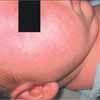Neonatal Acne in a 3-Week-Old Boy
The parents of a 3-week-old infant are concerned about the numerous small, erythematous papules and pustules on his cheeks. All the lesions were at a similar stage in development. The pregnancy was uneventful.

The parents of a 3-week-old infant are concerned about the numerous small, erythematous papules and pustules on his cheeks. All the lesions were at a similar stage in development. The pregnancy was uneventful.
Benjamin Barankin, MD, of Edmonton, Alberta, made the clinical diagnosis of neonatal acne. This inflammatory condition is thought to be a response to maternal androgens. Recent studies suggest that it may be triggered by Malassezia sympodialis.1,2 The term "benign cephalic pustulosis" is increasingly used for this condition.
The lesions may appear within the first 2 to 4 weeks of life and can last up to 6 months. Neonatal acne occurs primarily on the face; back and chest involvement is less common. Often patients have a family history of severe acne. It is possible that neonates with severe acne may be more prone to severe acne in adolescence. For infants with acne that persists for more than 12 months, an endocrine workup is indicated.
The differential diagnosis includes pustular miliaria, seborrheic dermatitis, milia, erythema toxicum, Malassezia pustulosis, and cutaneous candidiasis.
In most cases, the acne resolves spontaneously without treatment. Gentle facial cleansing with soap and water and application of topical benzoyl peroxide or topical tretinoin can be beneficial. Topical hydrocortisone with or without topical ketoconazole may also be beneficial, particularly in cases related to seborrheic dermatitis or a reaction to Malassezia.
This infant's acne resolved after a month with gentle facial cleansing, the application of 2.5% benzoyl peroxide, and the benefit of time.
References:
REFERENCES:
1.
Bergman JN, Eichenfield LF. Neonatal acne and cephalic pustulosis: is
Malassezia
the whole story?
Arch Dermatol.
2002;138:255-257.
2.
Bernier V, Wiell FX, Hirigoyen V, et al. Skin colonization by
Malassezia
species in neonates: a prospective study and relationship with neonatal cephalic pustulosis.
Arch Dermatol.
2002;138:215-218.
Recognize & Refer: Hemangiomas in pediatrics
July 17th 2019Contemporary Pediatrics sits down exclusively with Sheila Fallon Friedlander, MD, a professor dermatology and pediatrics, to discuss the one key condition for which she believes community pediatricians should be especially aware-hemangiomas.